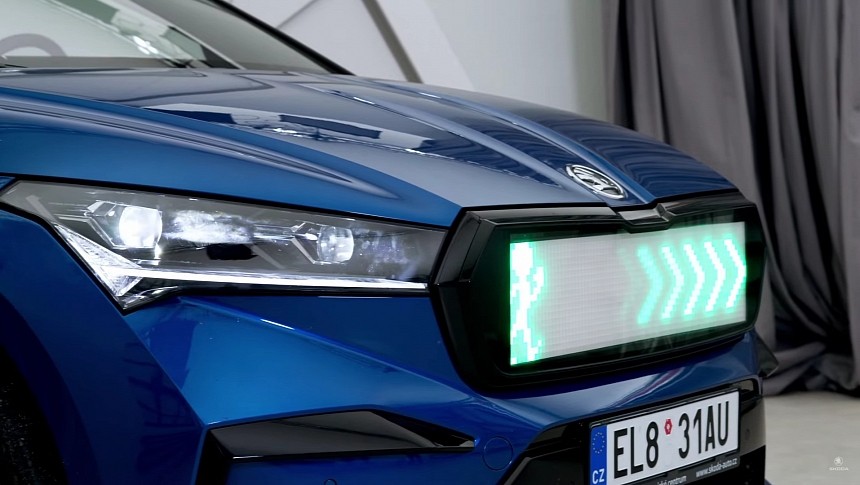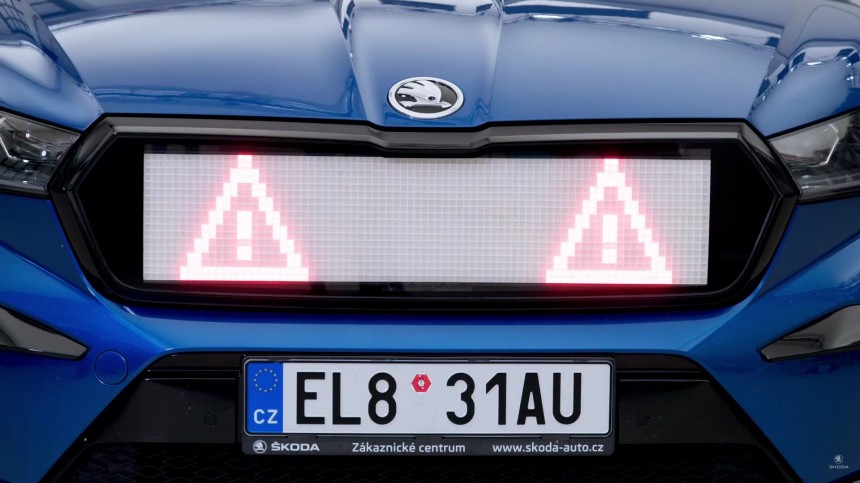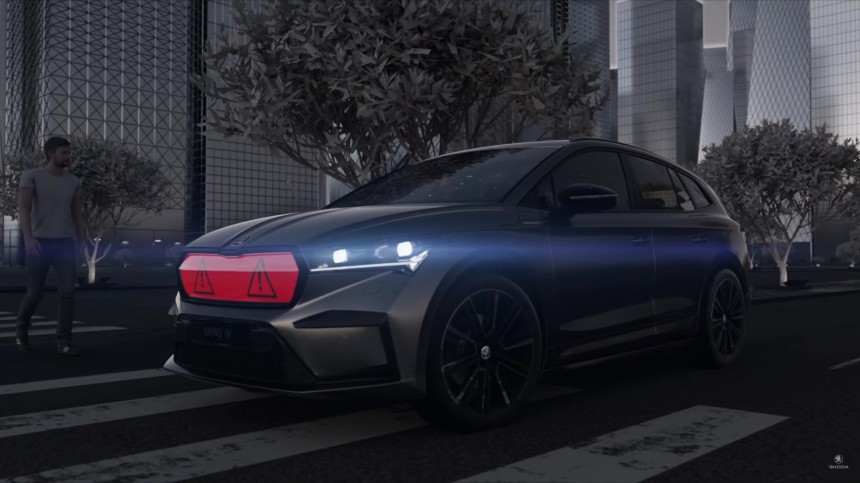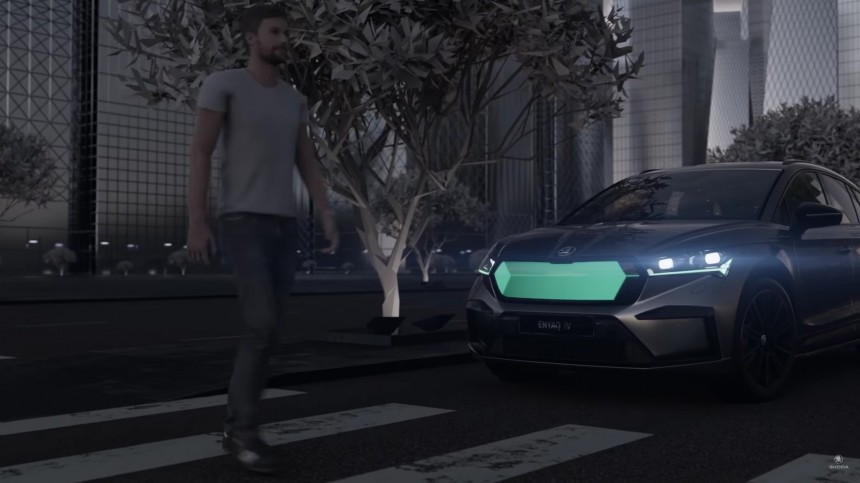"Why did the chicken cross the road? Because the autonomous automobile allowed it to." Not the punchline you'd expect, but it could become reality. The German-owned Czech carmaker Skoda is working on an intriguing feature for its (autonomous) automobiles. A traffic warning system installed on the front grille tells pedestrians whether or not it is safe to cross the street.
At first glance, putting a traffic light on the front of a moving car would seem counterintuitive, superfluous, redundant, useless, or plain nonsensical. After all, the various rules, regulations, and laws worldwide unanimously agree that cars stop, pedestrians cross the street, and vice versa, but both obey one regulating mechanism – the traffic lights.
Red means Stop, and green means Go – that's the whole philosophy of it, and it has worked flawlessly since its invention. However, Skoda tackles a new traffic paradigm: autonomous cars. Also, the system tested by Skoda is not addressed to the general public but to the more exposed spectrum of pedestrians: children, seniors, and disabled.
The Human Machine-Interface (HMI) consists of a grille-mounted LED panel that displays simple and concise symbols that are easily understandable, highly visible, and familiar. Play the first video for a demonstrative display of this traffic-regulating proposal.
The concept is relatively straightforward: a self-driving car with no driver behind the wheel could detect when people want to cross the street. The car will then stop, and the LED screen will show a sequence of green arrows and a figure of a person walking.
Skoda appeals to currently-used reference points, such as the color of the light (green, also found on all traffic lights, conveys the right of way) or the shape of the symbols – the arrow is also easily recognizable.
On the other hand, if the car computes that it cannot stop within a safe distance, a red-light warning triangle is displayed, alerting passers-by that it is unsafe to engage in crossing the street.
Skoda tested this system on an Enyaq iV model (in a contained and controlled environment) using eye-motion-tracking goggles to analyze participants' focus times and points. The results indicated that the front grille is the most appropriate zone to install the HMI display.
However innovative it may be, this passive safety mechanism – still in its beta-testing phase – is far from finding real-life practical applications on automobiles – for two main reasons. The first – and most impeding – is the lack of a legislator framework to standardize all the various aspects involved.
For example, civilian cars are not allowed to have any sort of colored lighting on the front and back – other than those homologated for production. Green and especially red are therefore forbidden as of now. Other less apparent aspects also lack a judicial structure, like the minimum size for such a display, the brightness and refresh rate of the LED symbols, or the symbols' shapes.
Installing the LED panel on the front grille is a second, less evident obstacle. While it wouldn't be a problem for EVs, it would obstruct the air intake for combustion engines. That's a far-fetched assumption, though, based on the presumption that future automobiles will continue to use piston power (and have autonomous capabilities simultaneously).
Aside from the car-adorning traffic lights, Skoda is testing another pedestrian aid – a robotic rover called IPA2X (see it in action in the second video). Also "designed to help children, seniors and people with disabilities cross the road safely," the seven-foot-tall (2.1 meters) gadget is a mobile intelligent traffic light.
It positions itself in the middle of a zebra and then shines a green light for pedestrians and a red one for cars. Equipped with LiDAR sensors, it can scan above parked cars, monitoring the street to decide if it is safe to intervene in traffic.
Additionally, it can communicate with an automobile's infotainment system and warn the driver about a change in traffic. After the foot walkers are safely on the other side of the road, the robot returns to the curb.
Red means Stop, and green means Go – that's the whole philosophy of it, and it has worked flawlessly since its invention. However, Skoda tackles a new traffic paradigm: autonomous cars. Also, the system tested by Skoda is not addressed to the general public but to the more exposed spectrum of pedestrians: children, seniors, and disabled.
The Human Machine-Interface (HMI) consists of a grille-mounted LED panel that displays simple and concise symbols that are easily understandable, highly visible, and familiar. Play the first video for a demonstrative display of this traffic-regulating proposal.
Skoda appeals to currently-used reference points, such as the color of the light (green, also found on all traffic lights, conveys the right of way) or the shape of the symbols – the arrow is also easily recognizable.
On the other hand, if the car computes that it cannot stop within a safe distance, a red-light warning triangle is displayed, alerting passers-by that it is unsafe to engage in crossing the street.
However innovative it may be, this passive safety mechanism – still in its beta-testing phase – is far from finding real-life practical applications on automobiles – for two main reasons. The first – and most impeding – is the lack of a legislator framework to standardize all the various aspects involved.
For example, civilian cars are not allowed to have any sort of colored lighting on the front and back – other than those homologated for production. Green and especially red are therefore forbidden as of now. Other less apparent aspects also lack a judicial structure, like the minimum size for such a display, the brightness and refresh rate of the LED symbols, or the symbols' shapes.
Aside from the car-adorning traffic lights, Skoda is testing another pedestrian aid – a robotic rover called IPA2X (see it in action in the second video). Also "designed to help children, seniors and people with disabilities cross the road safely," the seven-foot-tall (2.1 meters) gadget is a mobile intelligent traffic light.
It positions itself in the middle of a zebra and then shines a green light for pedestrians and a red one for cars. Equipped with LiDAR sensors, it can scan above parked cars, monitoring the street to decide if it is safe to intervene in traffic.
Additionally, it can communicate with an automobile's infotainment system and warn the driver about a change in traffic. After the foot walkers are safely on the other side of the road, the robot returns to the curb.



























